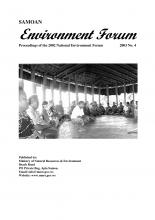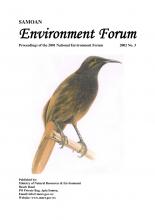Samoan Environment Forum : proceedings of the 2002 National Environment Forum|Samoan customary lands at the crossroads - some options for sustainable management / Tu'u'u Ieti Taule'alo|Sooialo David Fong & Patea Malo Setefano|Ethnotaxonomy of breadfruit cultivars in Samoa / Namulau'ulu G. Tavana|Population development verses sustainable development / Malaefono Taua Faafeu-Taaloga|Climate change and Samoa - Sustainable development / Tagaloa Bismarch Crawley|Urban development and uncontrolled discharge in Apia, Samoa / Paul Jones and John Cocks|Renewable energy: a renewed approach to sustainable development - a natural source of empowerment for the Pacific islands / Peniamina Doug Leavai|Sustainable agriculture : How do we get there in Samoa? / Aaron Kama|Worldviews, concepts, attitudes and awareness with regard to natural resource management in Samoa and other Pacific islands / Nacanieli S. Tuivavalagi|Some reflections on a sustainable development strategy for a least developed small island state, just graduated to developing country status / Afamasaga Faamatala Toleafoa
Climate Change Resilience
Available Online
2003

